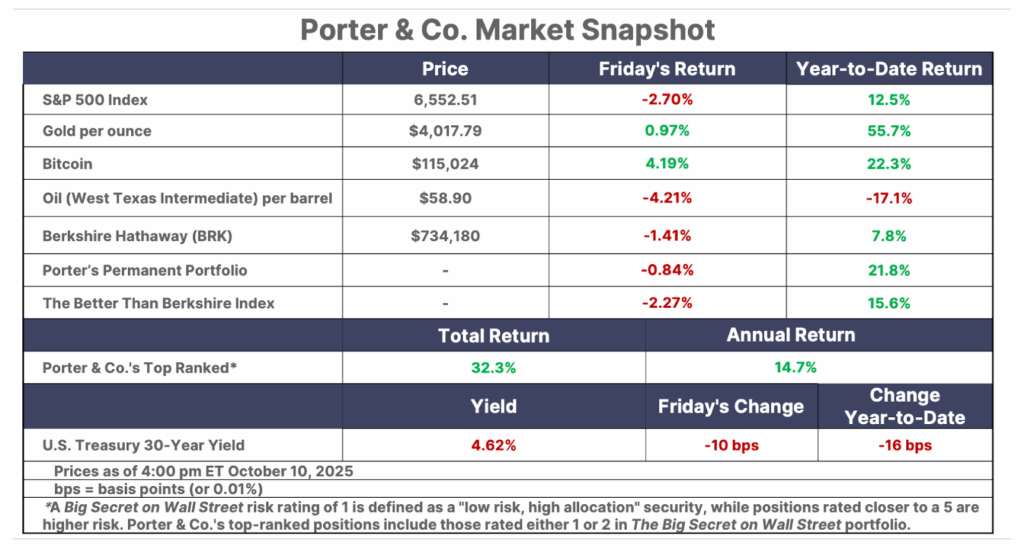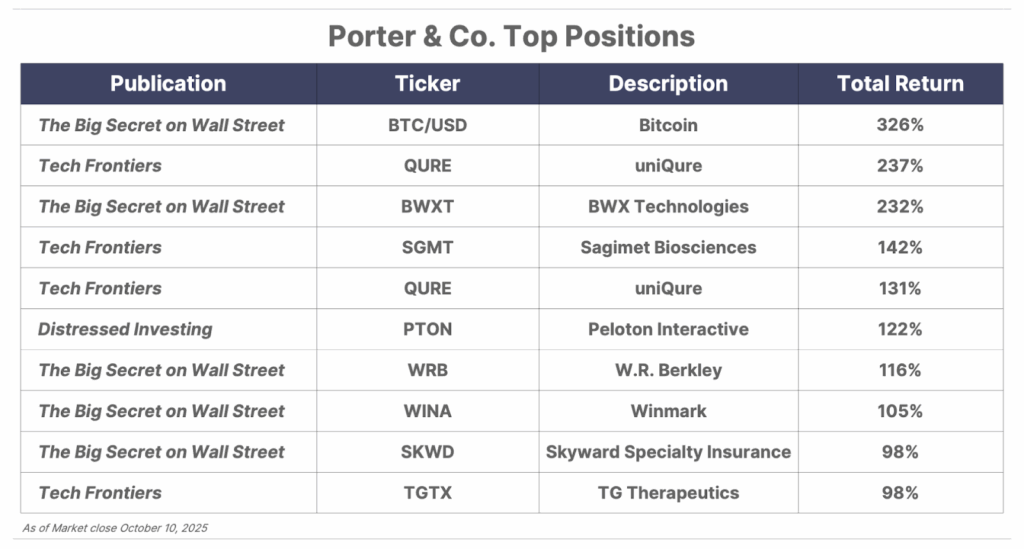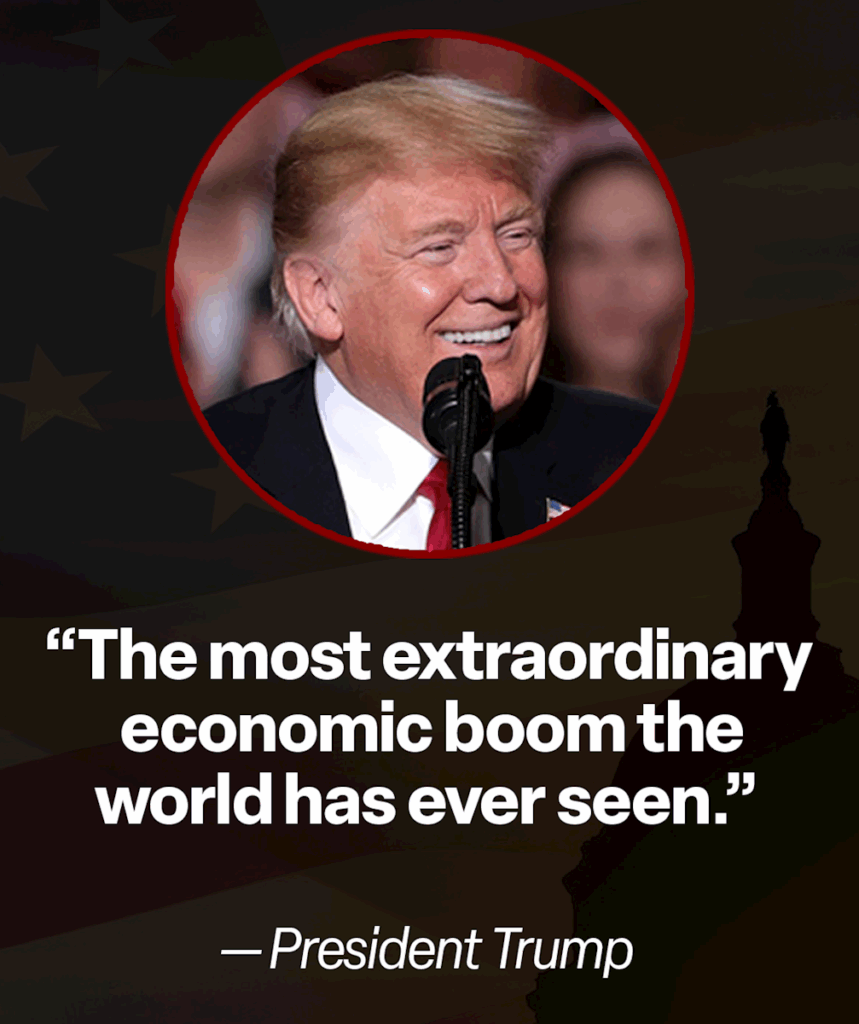Issue #118, Volume #2


It Praises Growth, Creative Destruction, And Free Trade
This is Porter’s Daily Journal, a free e-letter from Porter & Co. that provides unfiltered insights on markets, the economy, and life to help readers become better investors. It includes weekday editions and two weekend editions… and is free to all subscribers.
| Nobel Prize in economics… Free trade and creative destruction honored… Tariffs and protectionism pooh-poohed… Echoing Adam Smith and David Ricardo… The world needs to hear it… A crypto liquidation event… |
The Nobel Prize committee has seen the light.
Today, the Nobel Memorial Prize in Economic Sciences was awarded to three European economists, Joel Mokyr, Philippe Aghion, and Peter Howitt, for their decades of contributions to understanding the relationship between technological innovation and sustained economic growth.
Their work reveals how technological progress has transformed societies over the past two centuries, lifting billions out of poverty, improving health, and raising the overall standard of living. The Nobel award recognizes a powerful body of research that provides both historical insight and theoretical modeling, helping economists and policymakers better understand how growth happens – and how it can be nurtured in a world facing new challenges and rapid change.
For most of human history, economic development was slow and short-lived. Civilizations occasionally experienced bursts of prosperity because of specific inventions or favorable conditions, but these were rarely sustained over time. Growth would eventually plateau, often due to limited scientific understanding or institutional barriers. As John Hassler, chair of the Nobel committee, remarked during the announcement, “Despite important discoveries that improved living conditions, growth leveled off.” This pattern persisted for centuries until the Industrial Revolution unleashed waves of innovation and economic transformation.
Joel Mokyr, awarded half of the prize, has dedicated his scholarly career to understanding this historical pivot. In works such as A Culture Of Growth: The Origins Of The Modern Economy, Mokyr explores how intellectual, cultural, and institutional changes in Europe around the 17th and 18th centuries laid the groundwork for sustained innovation. He argues that the rise of a “culture of growth” – a society open to new ideas, technological experimentation, and scientific reasoning – was key to enabling the self-reinforcing loop of discovery, invention, and application that characterizes modern economic development.
Mokyr argues that innovation drives long-term growth, and to do so it must have an intellectual framework for explaining innovation and improvement. In other words, societies needed not only tools and machines but also the intellectual understanding of the principles behind their function in order to replicate them. Once scientific knowledge began to inform technological advancement, however, innovation became more cumulative and predictable – allowing for sustained growth.
Boom… The Theory Of Creative Destruction
The other half of the Nobel Prize was jointly awarded to Philippe Aghion and Peter Howitt for their development of a mathematical framework explaining how innovation fuels growth through a process known as “creative destruction.” Rooted in the ideas of economist Joseph Schumpeter, creative destruction describes a dynamic economic process where old technologies and business models are continuously displaced by newer, more efficient ones.
Aghion and Howitt’s model, introduced in the early 1990s, formalized this idea and became central to modern growth theory. Their approach illustrated how entrepreneurial innovation leads to productivity gains but also disrupts established firms and industries. Steve Jobs’ invention of the smartphone improved communication – but more importantly, it rendered older forms of communication… such as landlines… largely obsolete. In doing so, the smartphone captures both the promise and the turbulence of technological progress.

This framework provides a basis for understanding how government policy, competition, education, and institutions influence the rate and direction of innovation. It also highlights the dual-edged nature of growth: while innovation can drive higher incomes and better living standards, it can also lead to job displacement, inequality, and market concentration if not properly managed. It creates a mess, but oddly the mess becomes a much better place to live.
The committee’s decision to award this prize in 2025 is timely. The global economy is undergoing an enormous wave of transformation – this time led by artificial intelligence (“AI”) and other digital technologies. As AI reshapes industries, education, healthcare, and labor markets, the insights of Mokyr, Aghion, and Howitt become ever more relevant. Understanding how innovation leads to growth, and how to design institutions that foster inclusive innovation, will be essential for navigating the coming decades.
At the same time, new threats to growth have emerged. Protectionist policies – most obviously the Trump administration’s tariffs or China’s restrictions on critical mineral exports – risk slowing the global spread of technology and of new ideas. If the past two centuries have shown anything, it is that free trade, competition, and knowledge exchange are essential for innovation-driven growth. While the three winners did their own research, they no doubt did so on the shoulders of great economists who came before them.
Innovation, Growth, And Classic Free-Trade Theory
The awarding of the prize to these three economists is really based on the bedrock principles laid down by figures like Adam Smith, Milton Friedman, and David Ricardo, among others. Adam Smith, in his seminal The Wealth of Nations, articulated the concept of the “invisible hand,” arguing that individual self-interest, operating within a framework of free markets, could lead to collective prosperity. His emphasis on specialization, trade, and the division of labor forms the very foundation of modern economic thought, celebrating the power of decentralized decision-making and minimal government intervention.
David Ricardo further refined these ideas, particularly through his theories of comparative advantage and diminishing returns. Comparative advantage explains why nations benefit from trade – because some nations are better at things than other countries are, so only the best at growing soybeans grow soybeans and the best at making tractors make tractors. His work underscored the immense gains available through open markets and the efficient allocation of resources across borders.
Similarly, Milton Friedman, an advocate for free markets and limited government, championed the power of monetary policy and the dangers of excessive government spending. His work on the permanent income hypothesis and his defense of individual liberty against state encroachment are cornerstones of modern conservative economic thought. Friedman’s emphasis on the long-run stability achieved through consistent monetary policy and his skepticism toward discretionary fiscal intervention speak to a profound trust in the efficiency of markets when unburdened by regulation.
Ultimately, the awarding of the Nobel Prize this year acknowledges that classical economic ideas have powered trillions of dollars in innovations and made the world a much better place to live. Even better, it acknowledges these and pumps these ideas out through a global microphone at a time when the world needs to hear it.
In a world where short-sighted strongmen, populist movements, and a tendency toward socialist economics challenge globalization and free markets, the work of these economists offers a powerful reminder: sustained economic growth does not occur by accident. It requires not just technological breakthroughs but the cultural, institutional, and policy environments that allow innovation to flourish.
What House Insider Buck Sexton:
“Trump’s Next Move Will Shock The World”
It could single-handedly reshape the global order… dramatically increase U.S. power… and trigger a massive American market boom the likes of which we haven’t seen in 75 years.
Three Things To Know Before We Go…
1. Tariff volatility continues. The major U.S. equity indexes suffered their biggest one-day decline since April’s tariff announcements on Friday, following President Donald Trump’s warning that he was considering “a massive increase of tariffs on Chinese products” in response to China’s announcement that it was imposing export controls on rare earth elements. The selloff accelerated in after-hours trading – including a historic liquidation in the crypto markets (see below) – when Trump announced he would impose additional tariffs of 100% on all Chinese imports effective November 1. However, as has been the case following previous escalations, both Trump and the Chinese government walked back their respective comments on Sunday, causing stock market futures to rebound sharply last night. And as we write, the major U.S. indexes are up well over 1%, on pace for their best day since August.
2. Friday marked one of the largest liquidation events in crypto history. More than $19 billion in leveraged crypto positions were wiped out across centralized exchanges, instantly liquidating over 1.6 million traders. Within an hour of the market close, Bitcoin plunged 13% to $106,128. The scale of this liquidation dwarfs previous major selloffs – it was 19x larger than both the FTX collapse and the March 2020 crash. The cascade was triggered, as mentioned above by President Trump’s threat to impose 100% tariffs on Chinese imports, sparking a global risk-off move that briefly rattled digital assets. However, as tensions eased and the China rift proved less severe than feared, Bitcoin rebounded, now trading above $114,000 as markets stabilize.

3. Dutch government usurps control of Chinese chipmaker. On Sunday, the Dutch Minister of Economic Affairs announced an emergency measure to take governance control over Chinese chipmaker Nexperia. The move allows the Dutch government to reverse decisions made by Nexperia deemed harmful to the country’s supply of semiconductors. This marks the first high-profile move by a European country to formally restrict Chinese chipmakers on the continent, and thus opens a new front in the widening trade war between the West and China.
Tell us what you think of today’s Daily Journal or anything else: [email protected]
Good investing,
Porter & Co.
Stevenson, Maryland


Please note: The investments in our “Porter & Co. Top Positions” should not be considered current recommendations. These positions are the best performers across our publications – and the securities listed may (or may not) be above the current buy-up-to price. To learn more, visit the current portfolio page of the relevant service, here. To gain access or to learn more about our current portfolios, call our Customer Care team at 888-610-8895 or internationally at +1 443-815-4447.
